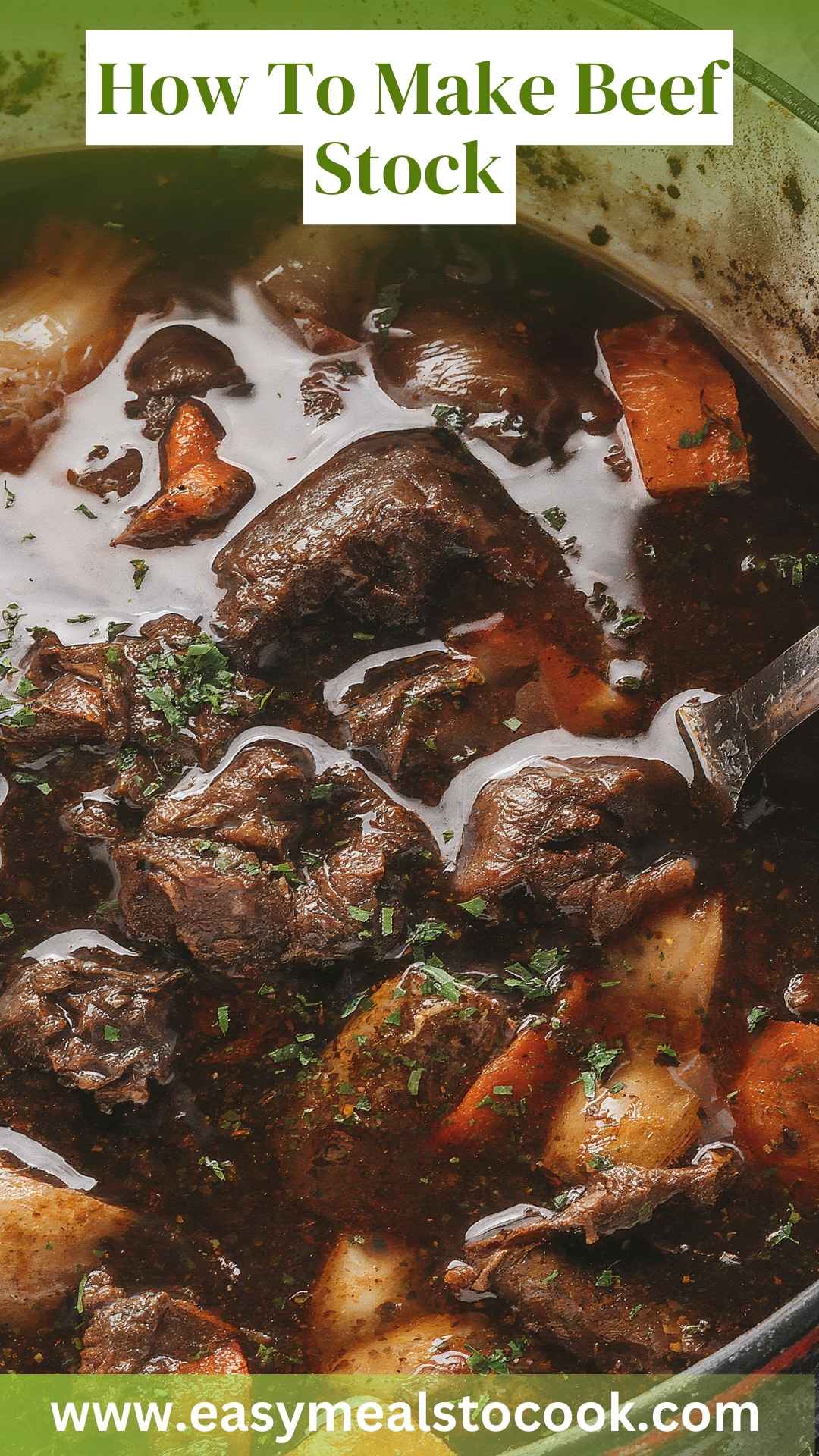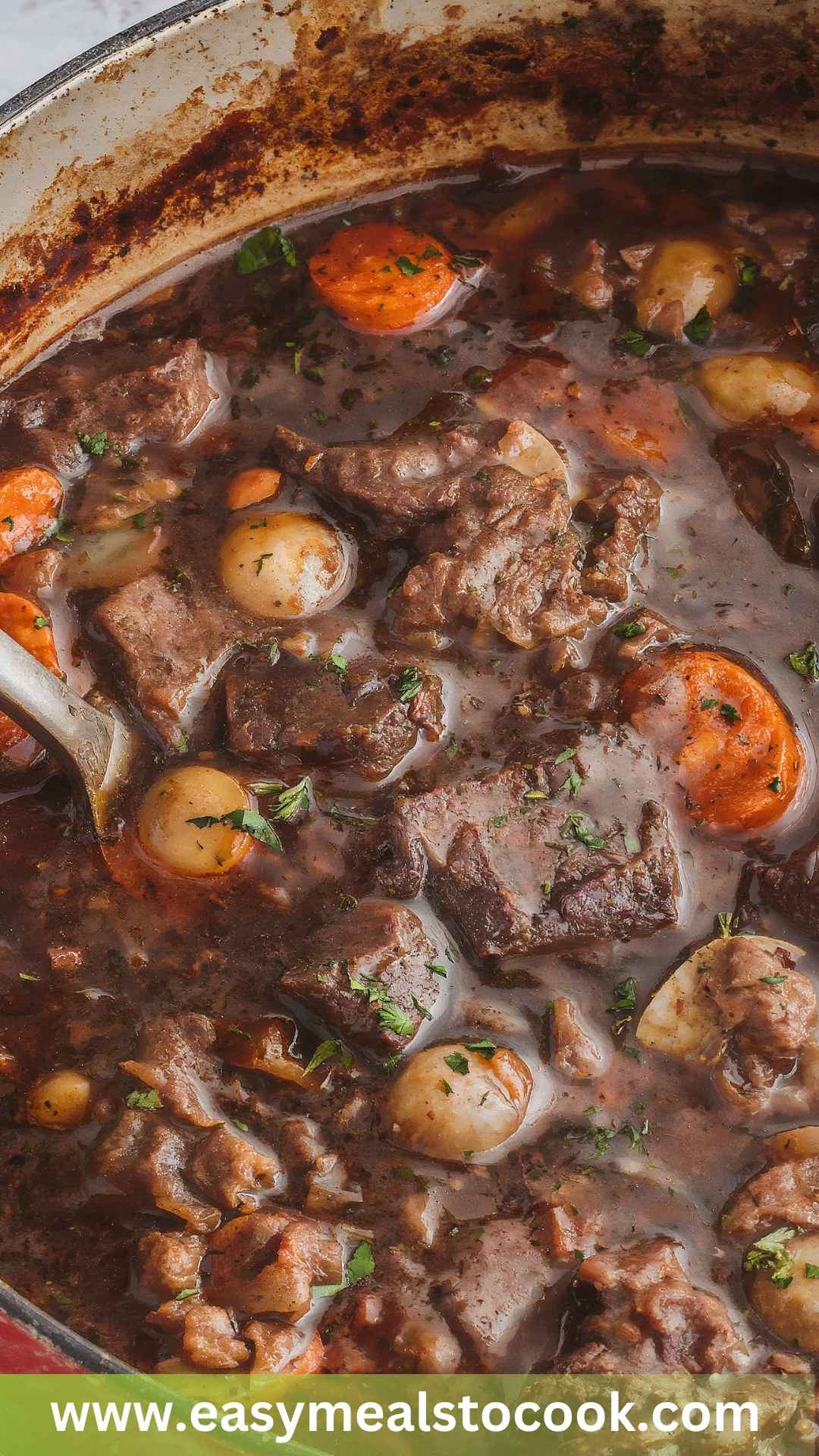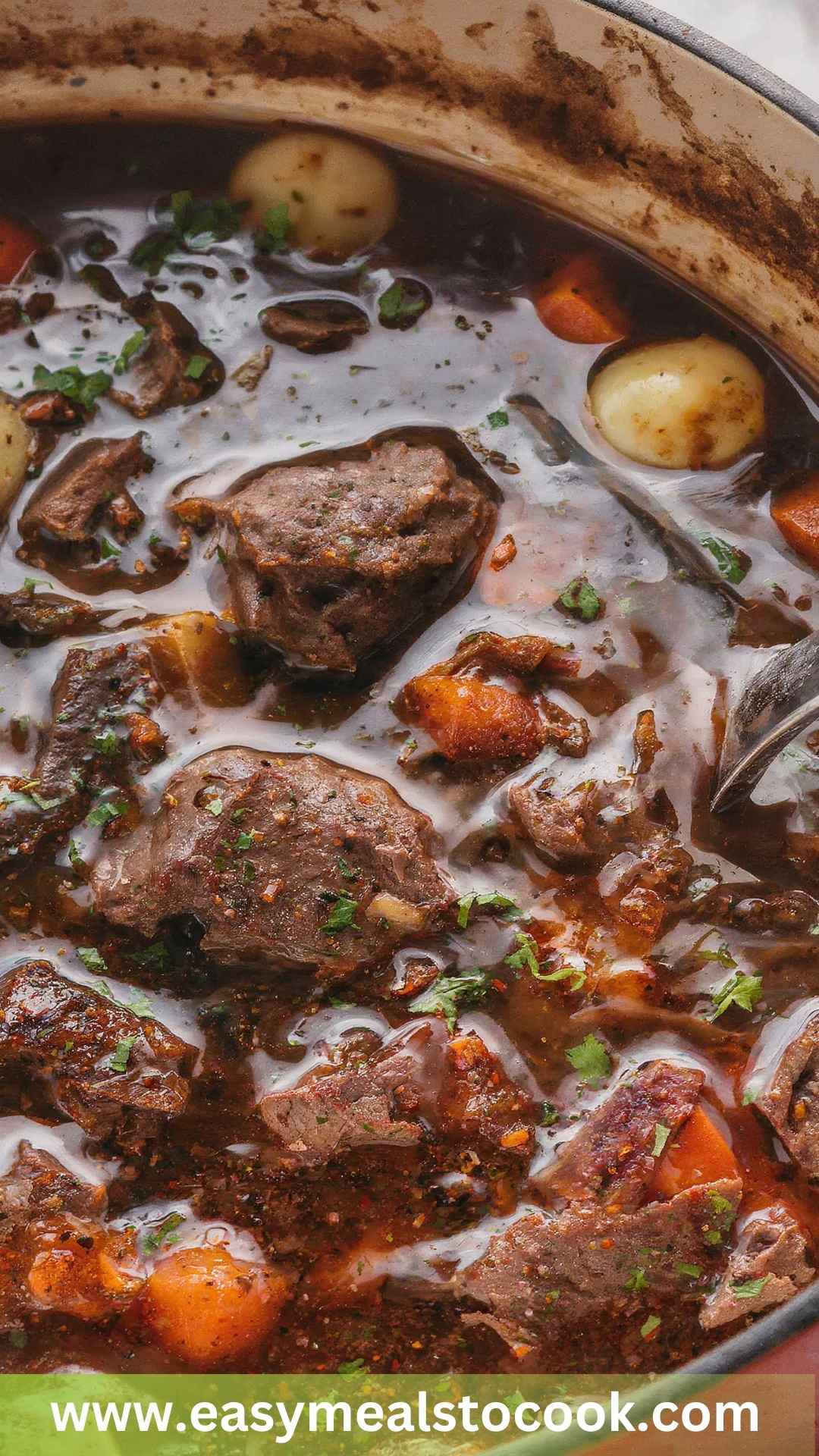Sometimes, the simplest things bring the most comfort. A warm bowl of soup, a hearty stew, or perhaps a savory sauce all have one golden key ingredient: a rich, homemade beef stock. But what can you pair with beef stock? Picture this: a fragrant spring vegetable risotto, maybe a minestrone bursting with fresh herbs, or even a creamy mushroom soup. Each of these dishes is elevated with the depth of flavor that only a proper beef stock can provide.
Today, I’m excited to share how to create your own beef stock at home. Why trust my take on this? Well, as a registered dietitian and passionate cook, I’ve spent years in kitchens experimenting with flavors and striving for simplicity without sacrificing taste. I’ll show you not only how to make this stock, but I’ll also share tips, tricks, and a few stories from my culinary adventures. Grab your apron; we’re about to embark on a flavorful journey.

What is Beef Stock?
Beef stock is a basic yet essential liquid made by simmering beef bones with vegetables and aromatics. It’s utilized in a variety of dishes to enhance their flavor. Unlike broth, which is often made from meat, stock focuses primarily on bones, resulting in a rich flavor and nutrient content.
Why This Recipe Works
Why should you follow my beef stock recipe? Here are four compelling reasons:
1. Simple Ingredients:
You can make beef stock using easily sourced ingredients. Bones, vegetables, and water are the core. This simplicity doesn’t compromise flavor; rather, it enhances it. Often, the best flavors come from very basic items.
2. Time Investment for Rich Rewards:
Sure, it takes time to simmer, but the rewards are well worth it. The long, slow cooking allows the bones to release collagen, gelatin, and nutrients, making a nutrient-rich stock that’s flavorful and healthy. It’s a love letter to time well spent in the kitchen.
3. Versatile Uses:
This stock can be a base for countless dishes. Want to make soup? You’ve got that covered. Planning a risotto? Here’s your go-to liquid. Looking for a sauce base? Beef stock is waiting to lend its richness. Trust me; there’s no limit to how you can utilize this liquid gold.
4. Money Saver:
Making your own stock at home can be a cost-effective choice. Store-bought alternatives can be pricey and often contain preservatives. By making your own, you control the ingredients, ensuring it’s both high-quality and budget-friendly.
Ingredients You’ll Need to Make Beef Stock
Before we jump into the magic of cooking, let’s gather the ingredients you will need to create this extraordinary beef stock. Here’s the breakdown:
- 2.5 kg / 5 lb beef bones (with plenty of meat; back and neck pieces recommended). These bones form the backbone of your stock.
- 1 marrow or knuckle bone: Adds depth and richness.
- 4 garlic cloves, smashed: Deepens the savory flavor.
- 1-inch piece fresh ginger, sliced: Adds gentle warmth and brightness.
- 1 whole carrot, unpeeled and sliced in half: Sweetness from fresh carrots balances the savory notes.
- 1/2 medium onion (brown or yellow), peeled and halved: The concentrated flavor adds depth.
- 2 ripe tomatoes, quartered (seeds left in): Brings a hint of acidity.
- 1/2 tablespoon coriander seeds: For a subtle spice.
- 1/2 tablespoon whole black peppercorns: Adds warmth and complexity.
- 1 celery stalk, cut into large chunks: Contributes another layer of flavor.
- 2 sprigs fresh thyme (or 1/2 teaspoon dried thyme leaves): Earthy and aromatic.
- 10 fresh parsley sprigs: Optional but recommended for an added freshness.
- 3 liters / quarts cold water: Essential for simmering your ingredients.
- 1 tablespoon raw apple cider vinegar: This helps extract nutrients from the bones.

How to Make Beef Stock
Now comes the fun part—making the stock! Follow these steps carefully, and you’ll soon have a pot of rich, simmering goodness.
Step 1: Prepare the Bones
Start by preheating your oven to 450°F (230°C). Place the beef bones on a baking sheet and roast them for about 30-40 minutes. You’ll want them to be deeply browned, as this gives your stock a rich color and flavor. Turn them halfway to ensure they roast evenly.
Step 2: Sauté the Vegetables
While the bones roast, heat a large stockpot over medium heat. Add a splash of oil. Once hot, toss in the onion, carrot, and celery. Sauté for about 5-6 minutes, or until the vegetables soften. This step builds the foundation of flavor.
Step 3: Combine & Simmer
Once the bones are ready, add them to the pot with the sautéed veggies. Sprinkle in the garlic, ginger, tomatoes, coriander seeds, and peppercorns. Pour in the cold water and vinegar. Bring everything to a boil, and then immediately reduce to a simmer.
Step 4: The Long Wait
Allow the mixture to simmer gently for 4–6 hours. You can simmer for up to 12 hours if you want an even richer stock. Occasionally skim off any foam or impurities that rise to the surface. This keeps your stock clear and clean.
Step 5: Strain the Stock
Once your stock has reached maximum flavor, it’s time to strain it. Use a fine mesh strainer or cheesecloth. Discard the solids, and you will be left with beautifully rich beef stock.
Step 6: Cool and Store
Let the stock cool to room temperature. If you wish, divide it into containers and refrigerate or freeze for future use. If you skim the fat off once cooled, your stock will be even lighter.
Tips for Making Perfect Beef Stock
Before you dive in, here are some handy tips to optimize your beef stock game:
- Use Variety in Bones: Mixing different bones like oxtail, shank, or neck can enhance flavor.
- Roast for Flavor: Never skip roasting the bones.
- Adjust Water Volume: More water results in thinner stock; less creates a concentrated flavor.
- Use a Slow Cooker: To make the process easier, you can use a slow cooker to simmer your stock overnight.
- Store in Portions: Pour stock into ice cube trays for easy, small measurements when needed.
Nutrition Information
Let’s talk nutrition. While the precise figures can vary based on the exact ingredients used and simmering time, a 1-cup serving of homemade beef stock averages around 30 calories.
- Calories: 500
- Fat: 0.5g
- Carbohydrates: 2g
- Vitamin A: 20% of the RDI
- Calcium: 1% of the RDI
This provides a solid base of vitamins and minerals, especially collagen, which is vital for joint health.
How to Store the Leftovers?
After you’ve made this incredible stock, you’ll want to store it properly. Let it cool entirely before transferring it to airtight containers. Here is how long it lasts:
- In the fridge: Up to 5 days.
- In the freezer: Up to 3 months. Consider freezing in smaller portions for easy access.
What are Some Recommended Side Dishes for Beef Stock?
Pair good food with good stock. Here are some excellent side dishes to consider:
1. French Onion Soup:
Using beef stock as a base, this classic guarantees a deliciously rich and cheesy experience, topped with crusty bread.
2. Risotto:
Use your homemade stock to infuse each grain of rice with unbelievable flavor. The creaminess combined with beef stock results in a comforting dish.
3. Beef Stroganoff:
This beloved dish benefits from the richness of beef stock, binding all elements together in a creamy sauce over egg noodles.
4. Braised Vegetables:
Use your stock as a braising liquid for seasonal vegetables. The stock elevates their natural flavors, transforming simple veggies into something special.
Substitute Options for Ingredients
What if you’re low on ingredients? Here are some substitutes for those key flavors:
1. Bones:
If you can’t find beef bones, turkey or chicken bones work as handy replacements for a lighter stock.
2. Vegetable Options:
Anyone can swap the carrot for parsnip or sweet potato for a different angle while maintaining the sweetness.
3. Herbs:
If you’re out of thyme or parsley, consider using rosemary or dill for an aromatic touch.
4. Apple Cider Vinegar:
Red wine vinegar can offer a similar acidity to balance flavors in your stock.

Conclusion
There you have it! Making beef stock isn’t just a fulfilling culinary exercise; it’s an act of care for you and those you feed. It brings flavors alive, setting the stage for countless meals. I hope this guide has inspired you to grab those bones, roll up your sleeves, and create a flavorful stock that not only enriches countless meals but warms your heart. So, pour yourself a cup of this liquid gold and foster your cooking adventures! Who knew that simplicity could lead to such magnificence? Happy cooking!
You’ll also like the following recipes!

How To Make Beef Stock – Easy Meals To Cook
Description
Sometimes, the simplest things bring the most comfort. A warm bowl of soup, a hearty stew, or perhaps a savory sauce all have one golden key ingredient: a rich, homemade beef stock. But what can you pair with beef stock? Picture this: a fragrant spring vegetable risotto, maybe a minestrone bursting with fresh herbs, or even a creamy mushroom soup. Each of these dishes is elevated with the depth of flavor that only a proper beef stock can provide.
Ingredients
Instructions
Step 1: Prepare the Bones
-
Start by preheating your oven to 450°F (230°C). Place the beef bones on a baking sheet and roast them for about 30-40 minutes. You'll want them to be deeply browned, as this gives your stock a rich color and flavor. Turn them halfway to ensure they roast evenly.
Step 2: Sauté the Vegetables
-
While the bones roast, heat a large stockpot over medium heat. Add a splash of oil. Once hot, toss in the onion, carrot, and celery. Sauté for about 5-6 minutes, or until the vegetables soften. This step builds the foundation of flavor.
Step 3: Combine & Simmer
-
Once the bones are ready, add them to the pot with the sautéed veggies. Sprinkle in the garlic, ginger, tomatoes, coriander seeds, and peppercorns. Pour in the cold water and vinegar. Bring everything to a boil, and then immediately reduce to a simmer.
Step 4: The Long Wait
-
Allow the mixture to simmer gently for 4–6 hours. You can simmer for up to 12 hours if you want an even richer stock. Occasionally skim off any foam or impurities that rise to the surface. This keeps your stock clear and clean.
Step 5: Strain the Stock
-
Once your stock has reached maximum flavor, it’s time to strain it. Use a fine mesh strainer or cheesecloth. Discard the solids, and you will be left with beautifully rich beef stock.
Step 6: Cool and Store
-
Let the stock cool to room temperature. If you wish, divide it into containers and refrigerate or freeze for future use. If you skim the fat off once cooled, your stock will be even lighter.
Nutrition Facts
Servings 1.5
- Amount Per Serving
- Calories 500kcal
- % Daily Value *
- Total Fat 0.5g1%
- Total Carbohydrate 2g1%
* Percent Daily Values are based on a 2,000 calorie diet. Your daily value may be higher or lower depending on your calorie needs.
Note
- Use Variety in Bones: Mixing different bones like oxtail, shank, or neck can enhance flavor.
- Roast for Flavor: Never skip roasting the bones.
- Adjust Water Volume: More water results in thinner stock; less creates a concentrated flavor.
- Use a Slow Cooker: To make the process easier, you can use a slow cooker to simmer your stock overnight.
- Store in Portions: Pour stock into ice cube trays for easy, small measurements when needed.





